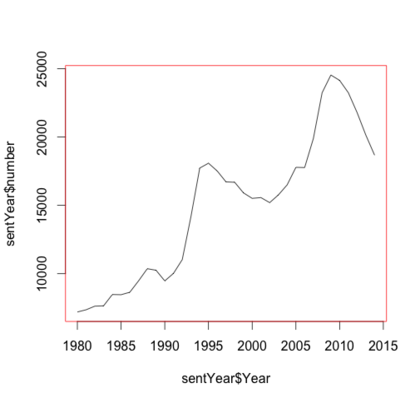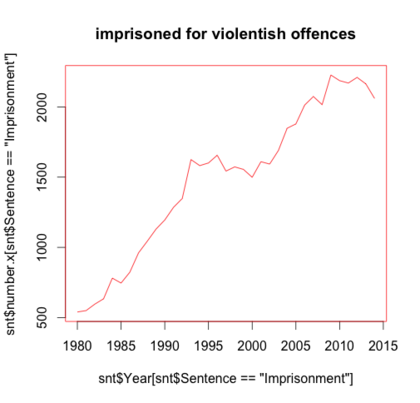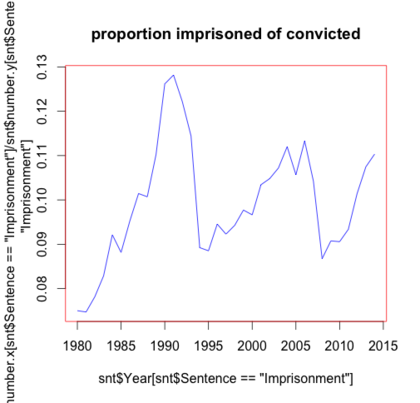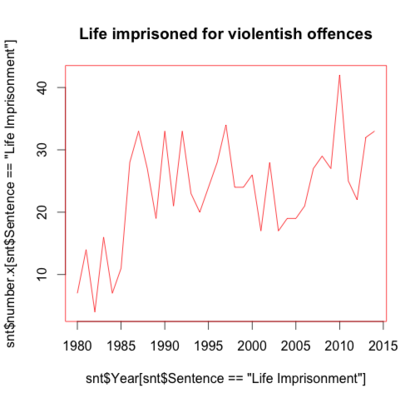Legal Beagle: The Greg King Memorial Blogpost: Three Strikes, Five Years On (now retracted)
47 Responses
First ←Older Page 1 2 Newer→ Last
-



More graphs. For the cluster of offences I called “violentish” above (because within them lie the really serious ones). We know from above that the reporting rate looks flat with cycles above. Here is the conviction raw numbers for those (black line graph, rising cyclical). The imprisonment raw numbers for those (rising, not as cyclical) and the proportion imprisoned of those convicted (blue steady cyclical, but we haven't talked proportions anywhere else, it really just shows the raw number peaks in convictions don't relate to imprisonments).
So flat cyclical reports, rising cyclical convictions, rising imprisonment. Take home point: Comparing times is complicated.
-
-
It may be interesting to compare the two time periods by sentence type. Were more people in the first time period convicted of a ‘strikeable’ offence sent to prison. And out of the group sent to prison, were they more or less likely to commit a 2nd 'strikeable' offence.
-
Graeme I think you need to account for the age of the person at the time of the offences. As I understand it there is a reducing offence rate as people get older, over 30 years old. Is that a factor"
-
Kumara Republic, in reply to
Graeme I think you need to account for the age of the person at the time of the offences. As I understand it there is a reducing offence rate as people get older, over 30 years old. Is that a factor”
Again, there was mention in that Investigate Magazine link (ahem) of the theory mentioned in Freakonomics linking falling crime rates and the 1973 Roe vs Wade ruling. The writer of that article (probably Wishart himself) dismissed it out of hand – among other ‘reality-based’ theories – in favour of the outmoded Dixon of Dock Green approach.
-
Graeme Edgeler, in reply to
Graeme I think you need to account for the age of the person at the time of the offences. As I understand it there is a reducing offence rate as people get older, over 30 years old. Is that a factor”
It's relevant to individual likelihood of reoffending, but not sure it would have too much of a factor overall over so short a time-frame (five years before, five years after). Probably something to look at longer term, however.
-
I would look at “time served” in both periods. In the first period jails were full so things like early release happened, in the second period parole rules changed. If people are still in jail they can’t (or are less able to) commit a second strike offense.
The other thing is that first strikers may have become craftier – they are still committing crime but are doing so in such a way as to not get convicted either by not getting arrested, not getting charged or leaving less evidence to convict on. Unfortunately, that’s not really falsifiable.
-
David Hood, in reply to
Unfortunately, that’s not really falsifiable.
It should show up in reported crime, if nothing else (unless you are positing the crimes are so crafty no one notices them, which is not likely in the case of strike offences).
-
A reason for crime rate drops apart from efficacy of strikes could be found by looking at lead in our petrol. I shit you not. Read this. http://m.motherjones.com/environment/2013/01/lead-crime-link-gasoline
The lag between lead being removed from petrol and crime rates dropping is 20 years - the approx peak age for offending. Lead was banned here in 96 so expect to see crime dropping for another year or two and then flatten off? -
Joe Wylie, in reply to
Lead was banned here in 96
Lead tetraethyl was a seriously vile neurotoxin, with a very effective lobby actively overselling its spurious benefits. The phaseout in NZ only began thanks to then Minister of the Environment Phil Goff, who prevailed over Energy Minister Bob Tizard in convincing Transport Minister Prebble.
At the time it was played as a generational victory within Labour, with the hapless Tizard claiming that it wasn't an issue in a "well ventilated" country like NZ.
-
linger, in reply to
The manufacturer of tetra-ethyl lead (a subsidiary of GM; commercial manufacture was subcontracted to DuPont) was well aware of the risk: the presence of lead was deliberately obscured by naming the additive simply “ethyl”. The inventor, Thomas Midgley Jr., was in 1923 hauled out to demonstrate the “safety” of TEL by pouring it over his hands and inhaling its vapour – though by this stage he had already had to take leave to recover from lead poisoning, and several plant workers had received fatal doses.
Midgley was later also responsible for the development of CFCs, leading J. R. McNeill to describe him as having
had more impact on the atmosphere than any other single organism in Earth’s history.
After contracting polio, he invented a machine to turn him over in bed … and was strangled by his sheets when it malfunctioned.
(You may have read about Midgley in Bill Bryson, A Short History of Nearly Everything ; his story was also covered on QI.)
-
Joe Wylie, in reply to
he invented a machine to turn him over in bed ... and was strangled by his sheets when it malfunctioned.
Midgely's life story would make a better movie than Ed Wood.
By way of a small footnote, leaded fuel contained an acid scavenging compound to prevent the buildup of lead deposits on internal engine components. When this acid compound recombined with the dampness that condenses on a cold exhaust from the combustion of hydrocarbon with oxygen in the air it formed pockets of wet acid.
Muffler shops loved lead tetraethyl and the rampant corrosion it produced. Now that it's gone, specialty exhaust chains such as Midas have had to reinvent themselves as general repair shops. Also spark plugs that formerly became fouled with lead residues now last much longer.
-
izogi, in reply to
That's a very interesting read. With a quick search I note that The Listener also had an article last year where they interviewed Rick Nevin and added some detail for NZ's context.
-
David Hood, in reply to mpledger, A day ago
<q>
Unfortunately, that’s not really falsifiable.
It should show up in reported crime, if nothing else (unless you are positing the crimes are so crafty no one notices them, which is not likely in the case of strike offences).
</q>But reported crime can't be disaggregated into second strike or not second strike if they don't know who did the crime.
-
Judge (and defence counsel) criticise the Three Strikes legislation as he sentences offender to seven years' jail for indecently assaulting prison officer.
I have no option but to sentence you to the maximum term of imprisonment prescribed for the offence - seven years' imprisonment. I agree that is very harsh given that what you did was not the most serious assault of its type, but Parliament has determined that your history of violent offending requires a very stern response to protect the public from you and to act as a deterrent to you and others.
"It may seem very surprising that this consequence could be required by law for an offence of this kind, but that is the law and I have no option but to enforce it.
"Were it not for the requirement to sentence you to the maximum term of seven years, the need to denounce your conduct, hold you accountable and deter others and you from such offending, it would likely have resulted in a period of no more than 12 months' imprisonment."
Toogood sentenced Campbell to seven years in prison, but Campbell is still able to apply for parole once a third of that term has passed.
Speaking after sentencing, defence counsel Sutcliffe indicated the law is an ass.
"It's an illustration as to why this is bad legislation. It's ill-considered and it needs revision.
-
Also from the Criminal Bar Association early this afternoon:
It is barbaric and contrary to the expectations of a liberal democracy that a judge is required to impose a seven-year sentence for a crime that he or she determines should receive a one year sentence.
It is also of note that there is no incentive for a person charged with a 3rd strike offence to plead guilty because the sentence will be exactly the same after a costly and pointless trial which exposes victims unnecessarily to the trauma of being in court. Criminal lawyers are already seeing a reluctance on persons charged with 2nd strike offences to plead guilty because they must serve the whole of the sentence imposed without parole and that tendency is likely to increase as 3rd strike offenders come before the court.
The number of prisoners has been increasing each year along with the cost which is likely to be $900 million dollars this year. That cost will continue to increase because of inappropriate sentences that judges will be required to impose as a result of the three-strikes legislation. There is an additional cost both financially and to society in excessive prison sentences because the longer a person spends in prison the more likely it is that he or she will reoffend when released.
The NZ Criminal Bar Association would prefer to see the additional money that will be required to keep 3rd strike offenders in prison spent on rehabilitation with the object of keeping the New Zealand population out of prison. It calls upon the government to repeal the three-strikes legislation before judges are required to impose further inappropriate sentences on third strike offenders.
-
Graeme Edgeler, in reply to
It is also of note that there is no incentive for a person charged with a 3rd strike offence to plead guilty because the sentence will be exactly the same after a costly and pointless trial which exposes victims unnecessarily to the trauma of being in court.
Odd to make this point following a case where the defendant pleaded guilty. Also, I would certainly see the guilty plea in this case as part of the reason the judge determined it manifestly unjust to refuse the possibility of parole.
-
izogi, in reply to
So, contrary to that press release, what would have been the man's incentive to plead guilty?
-
So, contrary to that press release, what would have been the man’s incentive to plead guilty?
Plead guilty so that:
1) the judge is more likely to allow him to have parole, which could knock 4 years 8 months of his sentence (the judge would "ordinarily" be required to impose a three strike sentence with no possibility for parole)
2) in the event that happens, make it more likely the parole Board will actually give him parole, if not at the first opportunity, then still earlier than it otherwise might (accepts he's guilty, acknowledges offending etc.) -
strike crime is down in general, but the ~20% fall in strike offending is dwarfed by the ~62% fall in strike recidivism.
If the number of cases has fallen from 256 to 81, that is a fall of 68.4%, not 62%.
-
As it is about a year since this was active, while the reporting of crime has changed, I can note that, if anything, the number of unique offenders per head population for the violentish crimes above proceeding to court seems to have steadily increased (and it certainly hasn't gone down).
-
Graeme Edgeler, in reply to
If the number of cases has fallen from 256 to 81, that is a fall of 68.4%, not 62%.
It's been a while since I wrote this, so am not sure the basis for my number. I think I accounted for the lower 1st strike offending (ie this is a proportion of those who committed what would have been first strikes who then committed what would have been second strikes). As strike crime was down, the recidivism rate per person who committed what would have been a first strike was not as great a fall.
Of course, that doesn't mean I didn't get it wrong, anyway :-)




Post your response…
This topic is closed.